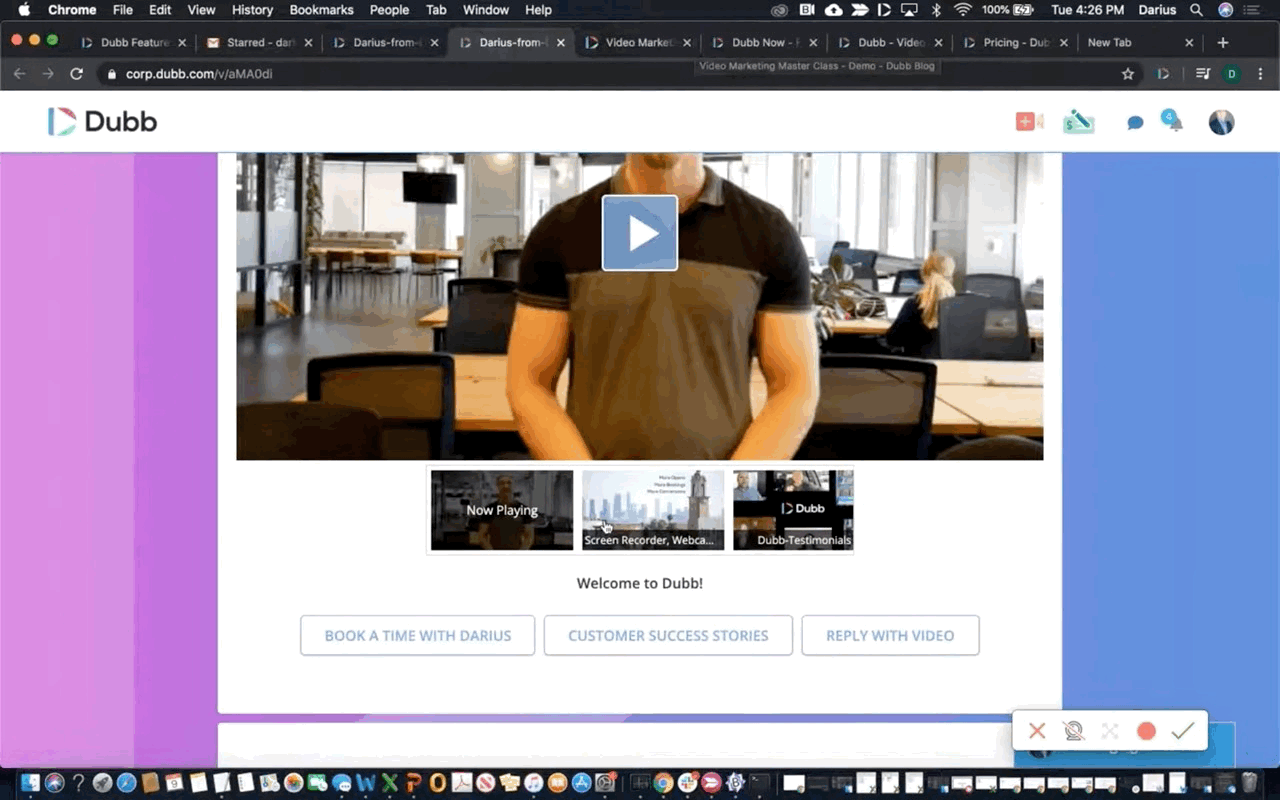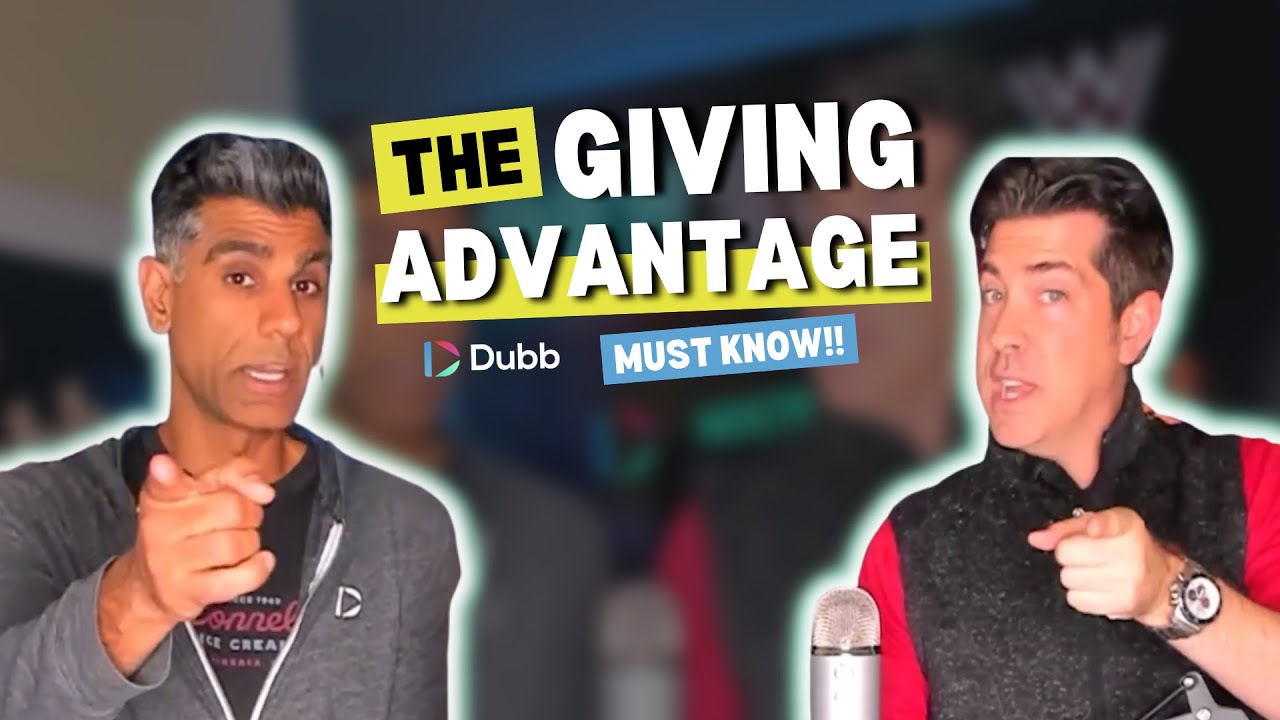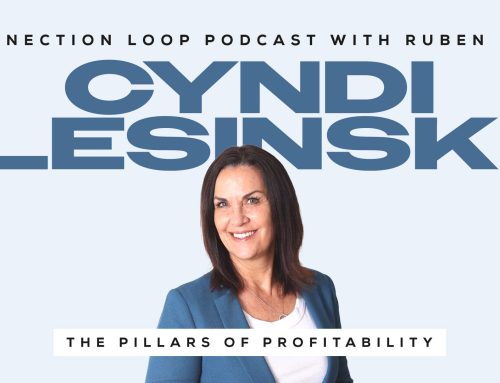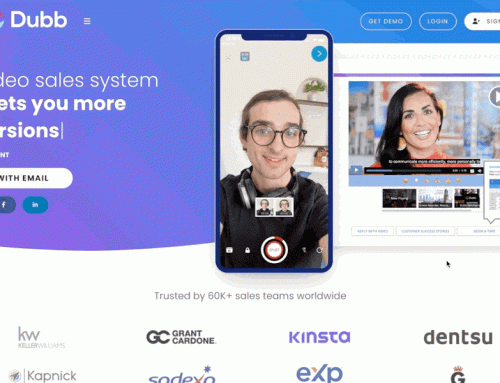At Dubb, the Giving Advantage is something that is always at the top of our minds. It can be a fantastic way to build extremely strong relationships with any type of audience, thereby increasing the chance that you turn interested prospects into paying customers. In fact, if you are not using this Giving Advantage, you’re not using the right method.
The Giving Advantage is especially important for sales professionals. For instance, if you are a sales leader, you and your team need to pay close attention to this. In the end, the Giving Advantage is all about mindset and how you want to impact the world. It leaves a lasting impact—both in a financial and a non-financial sense.
In this episode of RevShow, I wanted to further discuss the Giving Advantage and how sales leaders like you can leverage this extremely powerful idea. Whether you are struggling to reach your sales goals or want to take your sales goals to the next level, you can use the Giving Advantage starting right now.
This blog post summarizes a recent video that we recorded about the Giving Advantage. To watch the video in its entirety, go ahead and play the video above.

Being a Giver, Not a Taker
We have all heard of this one before. There are the givers and there are the takers. The last thing that you want is to be considered a taker. Think about it: would you want to make a purchase from someone who is perceived as selfish? Chances are not.
On the other hand, if you are thought to be a giver, you get to leverage so many positive things. Most prominently, you are seen as an empathetic, positive, and caring individual who wants to make others’ lives better. This leads to others more easily trusting you—even if they just met you. It wins respect and admiration. Not only that, but you feel better about yourself. Adopting a giving attitude gives you more self-confidence and raises your self-esteem.
As sales leaders, we need to remember to be generous. We need to be givers, not takers. Consequently, we also need to focus on providing an advantage to any given audience. That is a good part of what the Giving Advantage is all about. It is about offering value to any type of audience. That audience can be a single prospect or a much larger group of potential customers. Whoever that audience is, you can leverage the Giving Advantage by thinking of your audience first and ensuring that they are getting some type of value from your interaction.
The problem out there (which is a large-scale problem) involves perception. If you are in sales, you are generally perceived as being a taker. Even though the sales profession has a better reputation than it did decades ago, this taker designation still exists.
Because of this, a few things will happen. First, the guards of your prospects and contacts will be put up. When you are seen as a taker, not a giver, your prospects and contacts will find it much harder to develop a strong relationship with you. In the back of their minds, they will know that you ultimately have a financial goal in mind. On the other hand, salespeople that are seen as givers build trust more easily. Even though the prospect or customer knows that you have a financial interest in the relationship, you are providing substantial value upfront. In other words, you are making the prospect much better off before he or she pays your company one dollar. That simple fact helps build trust and helps you develop long-term relationships—even if you are a salesperson or sales leader.
Secondly, as a taker, you run the risk of damaging both the personal brand of the salesperson and the personal brand of the organization. It is very hard to recover from this. Takers aren’t viewed kindly. Even if you’re not the one acting as a taker, a colleague acting in this way can dramatically impact your own work. It makes it harder for other prospects to trust you and your organization, thereby reducing your potential sales rate. In sum, even if you think being a taker is beneficial to accomplish your own sales goals (which it likely isn’t), you are inadvertently causing collateral damage. However, if you are a giver, the positive attributes of being a giver can spread throughout your organization. Positive word of mouth among your prospects and customers can carry over to the organization as a whole. Not only do you get to build up some strong brand equity, but you can help your organization achieve its short-term and long-term sales goals.
The Psychology of Generosity
The big thing to remember is mindset. It is all about understanding something that is massively important. It has to do with the psychology of generosity.
When discussing this, I think it is helpful to analogize to filmmaking. In filmmaking, there is this idea of “saving the cat.” This is where audience members see the protagonist doing something kind (like helping save a cat in a tree or helping someone cross a street). There are plenty of examples of this in both old-school and modern-day films. The original idea comes from the film Aliens, where Sigourney Weaver’s character Ripley literally saved a cat.
When audience members see this, they suddenly start to care for the protagonist. They feel a connection to them—even if that same protagonist makes mistakes in the story. The reason why is that empathy, compassion, and connection are present. As audience members, we can relate to the protagonist when he or she goes off the beaten path to help something or someone.
We can apply these lessons to sales. At the beginning of any type of sales relationship, it is imperative that you use the Giving Advantage. That way, the people on the other side can build a connection with you. While you may not be literally saving cats in trees, adopting the giving mentality can go a long way in helping you build that goodwill and trust with your audience.

The Giving Advantage is all about being generous. You are being generous not only with your mindset, but with your actions and your strategy. The hard part, however, is being committed to the Giving Advantage for the long haul. The Giving Advantage is the long play. It is not the short play. What that means is that you’re focusing on relationships and your network—not on quick closes.
Essentially, what you are doing here is embracing delayed gratification. You aren’t trying to milk the most out of a one-time sales encounter and move on to the next prospect. This burn and churn strategy isn’t sustainable in the long term. By staying patient, being generous, and playing the long game, you can get the most out of the Giving Advantage.
Applying the Giving Advantage: Adjacent Value vs. Direct Value
There are two different ways to apply the Giving Advantage. The first involves the adjacent value that you bring. The second is the direct value that you can bring. Whether you choose to apply one or both strategies, these methods can help you provide upfront value, solidify trust, and generate more sales.
The Adjacent Value
The adjacent value is where you provide value that isn’t necessarily relevant to the product that you’re selling. Essentially, this means that you are helping someone outside of your sales goal. In other words, the assistance that you are providing isn’t directly tied to producing monetary compensation for you and your team. Yes, it may lead to monetary compensation down the road, but there is a time lag before that happens.
The adjacent value is extremely helpful because it is not salesy. On the contrary, it is about providing value without any expectation whatsoever. It is along the same lines of being a giver rather than a taker. By embracing the adjacent value, you are helping someone else solve some problem in their lives with zero expectation of an immediate return.
Now, I want to share a few specific examples of how you can provide adjacent value. Again, the general idea here is to provide value without expecting anything in return. If you are applying these strategies and hoping for an immediate payoff, you will likely find that these strategies don’t work. Your audience will quickly see through you and will have a lower opinion of you and your organization. Keep this in mind as you are applying these strategies in your day-to-day work.
The first idea here is to do some sort of an audit on some aspect of your target’s business. This could be a social media account, a website, or something that they already own and use. It can even be something like a newsletter or Substack that they publish to a certain audience.
The key here is to show them that there is some opportunity to improve and that you have the expertise to provide that value. Using video for something like this (specifically Dubb) is an extremely easy way to capture your content. For instance, you can take a look at your target’s social media page and use a quick Dubb video to record your thoughts. While the exact duration doesn’t matter, it should add some value to the end audience member. Once you have recorded your thoughts, you can then seamlessly convey that content over email, SMS, or LinkedIn. Again, the goal is to send that audit is both valuable and easy for your target to consume.
Remember that when you are doing this, it is not something product or service-related that you are selling. You are literally using the Giving Advantage by doing this. It’s happening because you are giving something to that person that has nothing to do with what you are selling. That is powerful and is the crux of the entire process.
The next example I want to share is all about complimenting social posts. This is really about being part of the party that your target is hosting online.
How does this work in practice? It is pretty simple. Check out what your target is doing and leave a comment. Don’t hesitate to offer a Like to what they are doing. Ultimately, really engage with their social media so they understand that you are someone out there that has taken notice of what’s going on. You can go the extra mile and direct message your particular target. Let them know how wonderful they are doing.
Another helpful idea is sending your target an article that might entertain them. As just one simple example, if your target is a fan of a certain sports team, send them an article or YouTube video that they may enjoy. If you see that they are a big foodie, go ahead and find an article about a hot, new restaurant in their city. Send it to them (along with a personalized message or note). This requires you to really know your target’s interests, so don’t hesitate to do a little research before you move forward with this strategy.
These are just some examples that you can implement in your day-to-day sales work. You may come up with others that are more relevant to your specific target. Whatever the case may be, there are plenty of ways that you can compliment your target’s social media posts.
Importantly, however, you must be genuine here. You can’t fake this. If you make a non-genuine compliment on your target’s Facebook page or LinkedIn page, he or she will immediately notice. It can harm the relationship—both now and in the future. Because of this, make sure that you are being absolutely genuine here. By offering genuine comments and feedback to your prospects, you are then able to capitalize on the adjacent value of the Giving Advantage.
The Direct Value
Now, let’s talk about the direct value.
With direct value, you are going to reach out to someone and you are giving something away in terms of value with your product or service. In other words, it is directly related to what you do in business. Unlike the adjacent value, the direct value is much more upfront about what it is that you are seeking.
What this means is that as a sales leader, you and your team should get in the habit of reaching out to people (i.e., prospecting) and giving something away of value. With the correct mindset, this can open the door and lead to dramatically more sales. By being upfront, I don’t mean that you should ask for the sale right away. That is more of a taker approach than a giver approach. Instead, what I mean is that you are providing some type of value that is directly connected with your product or service.
The first example here is sending your target some piece of education that is relevant to what you are selling. By doing this, the target can self-educate. They can truly understand the problem that your product and company is solving. While it may sound similar to sending that prospect a valuable article or YouTube video, the main difference here is its connection with your product or service.
For instance, it can be a webinar that you recorded on industry trends and how viewers can use your product or service to capitalize on those trends. On one hand, you are discussing those key industry trends that will impact your viewer regardless of whether they actually purchase your product or service. But on the other hand, you are also speaking about your product or service and how it can help the viewer capitalize on those trends. Creating this type of education is an outstanding way to show your knowledge of your sector while showing off the value that your product or service can provide.
The second example involves an introduction to someone that can actually help them in their business. This is incredibly powerful. Just think about it: you just let your target meet someone who is going to bring absolute value to them and help them with their business. It can completely change the course of that individual’s business. Granted, you should be putting some thought into this. You don’t want to make random connections that waste both your target’s time and your connection’s time. At the same time, making smart, intelligent introductions can be massively beneficial to your target. It is the epitome of the Giving Advantage.
Finally, let’s discuss a third example. If they are qualified and have expressed an interest, go ahead and provide a consultation to your target. Really, this just means giving them a deep dive into what it is that you do and how you can ultimately provide them with value. This consultation can be as short or as long as you’d like. At its core, you are using this opportunity as a way to show how your product or service can improve their lives. At this stage, you can be more upfront than you would be in other stages. Just remember, though: you do not want to be a taker. Make sure that you are giving and leading with value—even as you are potentially closing a deal.
These three examples are absolutely direct and absolutely value-facing. They epitomize the Giving Advantage and everything that it has to offer. If you want to apply the direct value, don’t hesitate to use any or all of these examples. You can even come up with your own. Feel free to lean on your creativity here.
Some More Tips on Implementing the Giving Advantage
Chances are that you have some thoughts in your mind. One of them may be along the lines of “Yes, the Giving Advantage makes sense. We should all provide value. But how does this actually work in practice?”
I think that one of the best ways to see is to simply get started. Feel free to use some of the examples above to apply the adjacent value or the direct value when communicating with a specific prospect. Beyond that, however, here are a few tips on getting the most out of the Giving Advantage.
One of the keys to the Giving Advantage is finding a way to get self-conversion. To do this, I recommend that you use videos with clear calls to action. The content can exist in the video frame and the calls to action can appear below that same video frame. The viewer can then pick and choose a specific call to action based on what their interest is.
Calls of action are extremely powerful. They make it extremely easy for your viewer to travel from point A to point B. Instead of wondering how they can follow up with you and your company, they can simply click on a button and travel further down your sales funnel. It is that easy.
Calls to action and the Giving Advantage have a close relationship. For instance, your viewer may watch your video and be thoroughly impressed. From there, they may want to book a consultation with you. Using a tool like Dubb, they can easily schedule a time on your calendar, as Dubb offers integrations with many of the most popular calendar booking services. All they need to do is click on that call to action below your video. If they are not quite ready to book a call, you may need to convince them on your next video. The overall point is that call to action buttons give the viewer the option to proceed as they’d like.

Another wonderful thing about calls to action is that you can take advantage of the “reply with video” call to action. Using Dubb, for instance, the reply with video feature lets you leverage so many benefits. It is truly amazing because you can use it to not only get a client or prospect’s thoughts, but to also get video testimonials. Video testimonials let you leverage social proof, which will go an extremely long way in helping you find new customers.
Recommendations are huge. They have been important throughout the entire history of sales. However, they have never been more powerful considering the networks that are out there. Recommendations are extremely influential, so don’t hesitate to take advantage of the reply with video feature. It makes it extremely easy to get testimonial videos, which directly lead to more social proof and more generated sales.
This next tip is a bit more sophisticated. However, it works for marketers that want to get the most out of the Giving Advantage. Here, I am talking about retargeting. That just means that if someone visits your video landing page or your website, you can have a trigger that retargets your advertising. This can be on Google, YouTube, Facebook, or any other channel.
Retargeting is so powerful because it inherently helps you spend time and effort on prospects who are more interested than the average person. Instead of simply buying a TV ad, for instance, and hoping that an interested prospect will watch the ad and contact you, you can use retargeting to be more effective and efficient. Using a tool like Dubb, you can set up automations and triggers based on how a certain prospect has interacted with your videos or website. Better yet, you can make that retargeting more personalized, making it more likely that you get closer to an ultimate sale.
The key here is to have your prospective audience discover advertisements that convey the value that you offer. Chances are that if they see an ad and they like it, they may click on it and actually convert themselves. Not to beat a dead horse, but adding value is critical within the Giving Advantage strategy. Even your ads should offer some type of value to the audience, whether that value is functional, emotional, or social. Don’t forget this as you leverage your retargeting strategy.
Three Big Takeaways
The Giving Advantage is a smart way to achieve your sales goals. Not only that, but you can build strong relationships that last for years (or perhaps even longer). Even if you and your colleagues are satisfied with your current sales processes, I recommend that you at least think about implementing the Giving Advantage in your day-to-day work.
In the end, what does this all mean for you?
First, always lead with giving. That is the number one mindset that you can’t forget. Don’t be a taker and think about how you can create or transfer value with your prospects, audience, and customers.
Secondly, focus on your relationships and your network. When doing so, don’t always expect something in return. Again, this is the giver attitude, not a taker attitude. Even though it may seem difficult to delay gratification, you are actually increasing your chances of a further reward down the road.
Finally, remember that the Giving Advantage is for the long haul. It is an investment made in the future. Ultimately, it is about having the right mindset and the right action. At the end of the day, however, the key is not expecting something in return.
I wish you all the best with the Giving Advantage. Now, it’s your turn to go out there and make it happen. I can’t wait to hear about all of your positive results!
RevShow is the channel that educates, entertains, and elevates sales leaders. To learn more about RevShow, Dubb, and how you can get started with our software, click here. You can also click here to get a free, 14-day trial of our premium plans.
A Final Note: Dubb Partners
One of the big things we have done at Dubb is create something called Dubb Partners. It used to be our affiliate program, but we have made it so much more powerful. The power comes from many different things, including the groups that we have, our strategy sessions, and more.
If you are one of the more than 60,000 Dubb users out there, we want to thank you. We also encourage you to become a Dubb Partner. By doing so, you can receive 30% recurring commissions. We have an almost 93% retention rate at Dubb, so as far as the affiliate landscape itself, Dubb Partners is incredibly powerful. We would love for you to be a part of it.
To do so, go to your Dubb dashboard. On the right, you will see a section that talks about Dubb Partners. You can click on the “Apply Now” button to get started with the Dubb Partners program. And if you aren’t yet a Dubb user? Go ahead and click here to learn more.





Leave A Comment